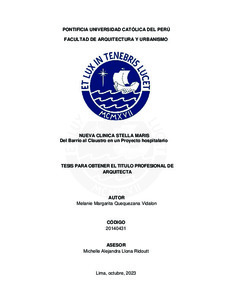| dc.contributor.advisor | Llona Ridoutt, Michelle Alejandra | |
| dc.contributor.author | Quequezana Vidalon, Melanie Margarita | |
| dc.date.accessioned | 2024-04-22T21:15:47Z | |
| dc.date.available | 2024-04-22T21:15:47Z | |
| dc.date.created | 2023 | |
| dc.date.issued | 2024-04-22 | |
| dc.identifier.uri | http://hdl.handle.net/20.500.12404/27659 | |
| dc.description.abstract | The COVID-19 pandemic put on the front page the national importance of being prepared
for emergencies, disasters and various social crises. The ability to provide quality health services
without interruptions becomes indispensable, and the design of hospital architecture is a way
of addressing the multiple factors that transform society, health, and the urban environment.
With the Mother House of the Missionary Mothers of the Sacred Heart remaining as the only
vestige of the original design, the extension of the Stella Maris Clinic, designed by the architect
Paul Linder in 1948, becomes a precise case study for the identification and analysis of strategies
for the design of an optimal hospital program, which have been lost today.
Faced with this situation, a proposal is designed that reinterprets the architectural qualities
designed by Linder, in order to recover the architectural quality of health services, while
promoting integration and positive impacts on the nearby urban environment.
The investigation starts from the analysis of the original planimetry of the PUCP Architecture
Archive, to identify strategies and potential elements for the project. These are superimposed on
the data collected “in situ”, where current project changes are identified, for the preparation of
graphs that support the proposal.
The value of the convent on which the design of the old clinic was born is recognized and
respected, in addition to the architectural and urban contributions of the proposal designed by
the architect Linder, in order to design a proposal that meets the needs of the current program ,
recovering the interior free spaces essential for quality in health services, in addition to promoting
the connection between the New Stella Maris Clinic and its urban environment. | es_ES |
| dc.description.abstract | La pandemia del COVID-19 puso en primera página la importancia nacional de encontrarse
preparados para emergencias, desastres y diversas crisis sociales. La capacidad de brindar
servicios de salud de calidad sin interrupciones se vuelve indispensable, y el diseño de la
arquitectura hospitalaria es una forma de abordar los múltiples factores que transforman la
sociedad, la salud y el entorno urbano.
Habiendo quedado la Casa Matriz de las Madres Misioneras del Sagrado Corazón como único
vestigio del diseño original, la ampliación de la Clínica Stella Maris, diseñada por el arquitecto
Paul Linder en el año de 1948, se convierte en un preciso caso de estudio, para la identificación
y el análisis de estrategias para el diseño de un óptimo programa hospitalario, las cuales han
sido perdidas en la actualidad.
Frente a esta situación, se diseña una propuesta que reinterprete las cualidades arquitectónicas
diseñadas por Linder, con la finalidad de recuperar la calidad arquitectónica de los servicios de
salud, promoviendo a su vez la integración y los impactos positivos en el entorno urbano cercano.
La investigación parte del análisis de la planimetría original del Archivo de Arquitectura PUCP,
para identificar estrategias y potenciales elementos para el proyecto. Estas se superponen a los
datos recopilados en “in situ”, donde se identifican los cambios del proyecto en la actualidad,
para la elaboración de gráficos que dan sustento a la propuesta.
Se reconoce y se respeta el valor del convento sobre el que nació el diseño de la antigüa clínica,
además de los aportes arquitectónicos y urbanos de la propuesta diseñada por el arquitecto
Linder, con el fin de diseñar una propuesta que satisfaga las necesidades del programa actual,
recuperando los espacios libres interiores indispensables para la calidad en los servicios de salud,
además de promover la conexión entre la Nueva Clínica Stella Maris y su entorno urbano. | es_ES |
| dc.language.iso | spa | es_ES |
| dc.publisher | Pontificia Universidad Católica del Perú | es_ES |
| dc.rights | info:eu-repo/semantics/openAccess | es_ES |
| dc.rights.uri | http://creativecommons.org/licenses/by/2.5/pe/ | * |
| dc.subject | Hospitales--Arquitectura--Estudio de casos | es_ES |
| dc.subject | Arquitectura--Aspectos sanitarios | es_ES |
| dc.subject | Arquitectura peruana | es_ES |
| dc.title | Nueva Clínica Stella Maris. Del barrio al claustro en un proyecto hospitalario | es_ES |
| dc.type | info:eu-repo/semantics/bachelorThesis | es_ES |
| thesis.degree.name | Arquitecto | es_ES |
| thesis.degree.level | Título Profesional | es_ES |
| thesis.degree.grantor | Pontificia Universidad Católica del Perú. Facultad de Arquitectura y Urbanismo | es_ES |
| thesis.degree.discipline | Arquitectura | es_ES |
| renati.advisor.dni | 40750595 | |
| renati.advisor.orcid | https://orcid.org/0000-0002-1123-0368 | es_ES |
| renati.author.dni | 70838316 | |
| renati.discipline | 731026 | es_ES |
| renati.juror | Arquero de Alarcon, Maria | es_ES |
| renati.juror | Rodriguez, Fernando | es_ES |
| renati.level | https://purl.org/pe-repo/renati/level#tituloProfesional | es_ES |
| renati.type | https://purl.org/pe-repo/renati/type#tesis | es_ES |
| dc.publisher.country | PE | es_ES |
| dc.subject.ocde | https://purl.org/pe-repo/ocde/ford#6.04.08 | es_ES |







